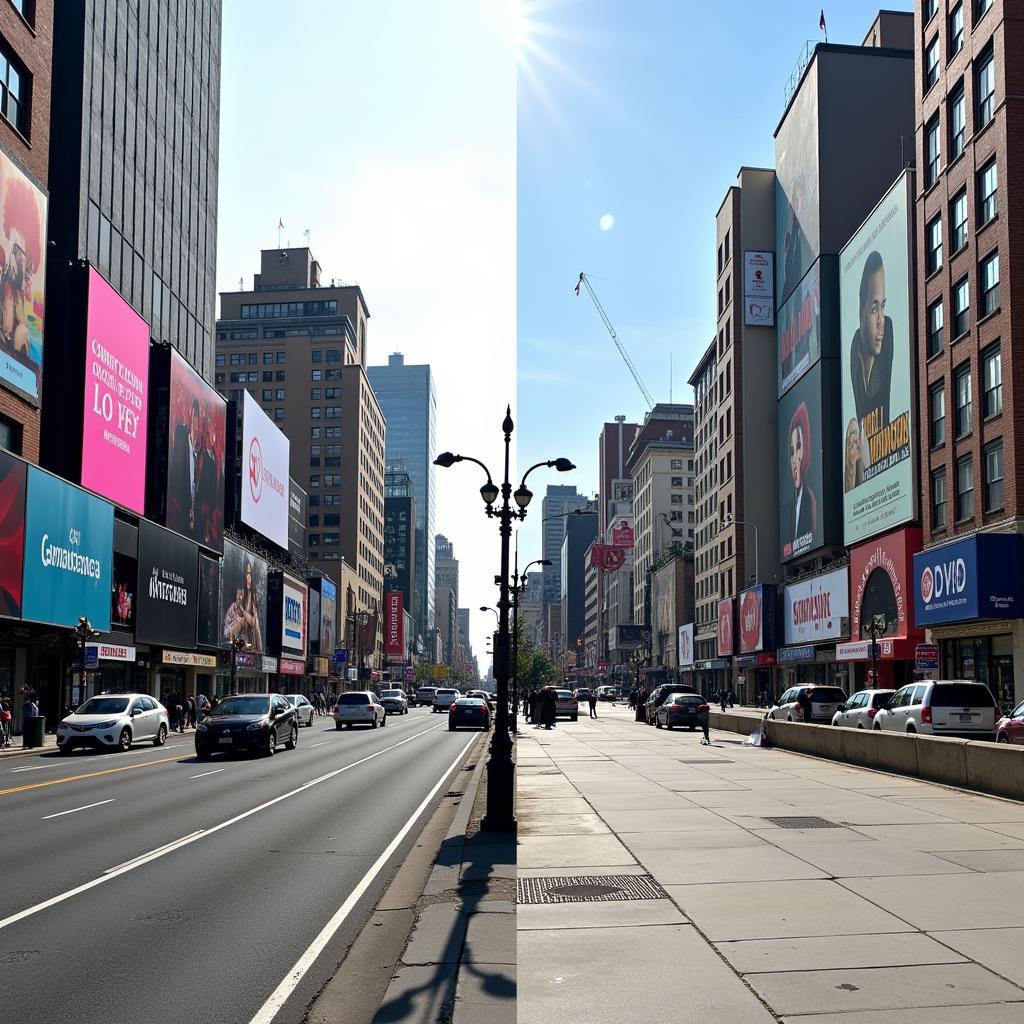The topic of advertising in public spaces has become increasingly prominent in IELTS Writing Task 2, appearing in various forms over the past few years. Similar to should there be a limit on advertising, this topic tests candidates’ ability to analyze the complex relationship between commercial interests and public welfare.
 Public spaces filled with advertising billboards versus clean urban environment
Public spaces filled with advertising billboards versus clean urban environment
Analysis of Real IELTS Question
Some people believe that public spaces should be free of advertisements, while others think advertisements should be allowed in public spaces. Discuss both views and give your own opinion.
This question requires candidates to:
- Examine both perspectives on advertising in public spaces
- Present balanced arguments
- Provide a clear personal stance
- Support ideas with relevant examples
Band 8.5 Sample Essay
In the modern urban landscape, the presence of advertisements in public spaces has sparked considerable debate. While some advocate for advertisement-free public areas, others support commercial messaging in these spaces. In my opinion, while complete elimination of advertisements may be impractical, strict regulations should govern their presence in public spaces.
Those who oppose advertisements in public spaces present compelling arguments. Firstly, excessive advertising can create visual pollution, diminishing the aesthetic appeal of cities and natural landscapes. Moreover, constant exposure to commercial messages can lead to mental fatigue and stress, particularly in spaces meant for relaxation and community gathering. This perspective aligns with how technology is impacting personal data privacy, where concerns about intrusion into personal space are paramount.
Conversely, proponents of public advertising highlight its economic and practical benefits. Advertisements generate substantial revenue for local authorities, which can be reinvested in public infrastructure and services. Additionally, some argue that well-designed advertisements can enhance urban spaces by adding vibrancy and character, similar to how should alcohol advertisements be restricted debates consider the cultural impact of commercial messaging.
In my view, a balanced approach is necessary. While complete prohibition of advertisements might be unrealistic and economically detrimental, strict regulations should govern their size, content, and placement. Public spaces should primarily serve community needs, with advertising playing a secondary, controlled role. This could involve designating specific areas for advertisements while maintaining advertisement-free zones in parks, historical sites, and cultural centers.
Band 6.5 Sample Essay
Nowadays, many people discuss whether advertisements should be allowed in public spaces or not. This essay will look at both sides of this issue and give my opinion.
Some people think public spaces should not have any advertisements. They say that too many advertisements make cities look ugly and disturb people’s peace. For example, big billboards on streets can block nice views and make people feel stressed. Also, some advertisements are not suitable for children to see.
However, other people believe advertisements in public spaces are good. They think advertisements help businesses grow and give money to the city government. This money can help build better roads and parks. Also, some advertisements give useful information to people about local events or important messages.
I think both sides have good points, but I agree more with controlling advertisements instead of banning them completely. We should have rules about where advertisements can be put and what kind they can be. This way, we can keep some benefits of advertising while protecting public spaces.
Scoring Analysis
Band 8.5 Essay
- Task Response: Fully addresses all parts with well-developed arguments
- Coherence and Cohesion: Logical organization with clear progression
- Lexical Resource: Sophisticated vocabulary usage
- Grammatical Range: Complex structures used accurately
Band 6.5 Essay
- Task Response: Addresses main points but less developed
- Coherence and Cohesion: Basic organization with some progression
- Lexical Resource: Adequate but repetitive vocabulary
- Grammatical Range: Mix of simple and complex structures
Key Vocabulary
- Visual pollution (n) /ˈvɪʒuəl pəˈluːʃən/ – unattractive visual elements in an environment
- Aesthetic appeal (n) /esˈθetɪk əˈpiːl/ – beauty or attractiveness in appearance
- Mental fatigue (n) /ˈmentl fəˈtiːɡ/ – psychological exhaustion
- Vibrancy (n) /ˈvaɪbrənsi/ – energy and enthusiasm
- Infrastructure (n) /ˈɪnfrəstrʌktʃə/ – basic physical systems of a country
- Detrimental (adj) /ˌdetrɪˈmentl/ – causing harm or damage
- Prohibition (n) /ˌprəʊɪˈbɪʃn/ – formal forbidding of something
- Reinvested (v) /ˌriːɪnˈvest/ – put money back into something
Remember to practice writing your own response to this topic and share it in the comments section for feedback. Future exam variations might include questions about digital advertising in public spaces or the impact of advertisements on different demographic groups.


